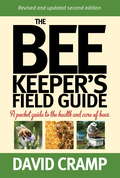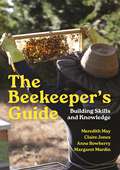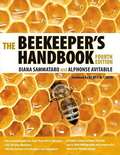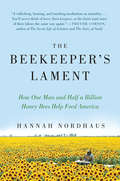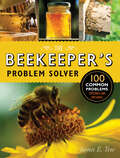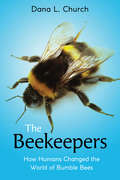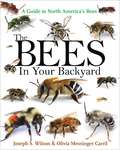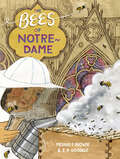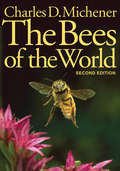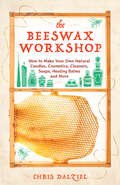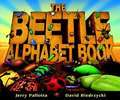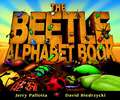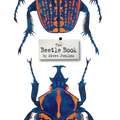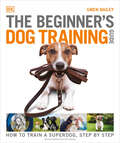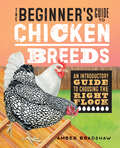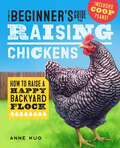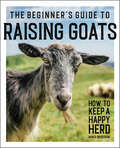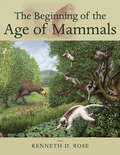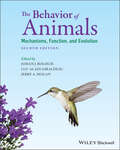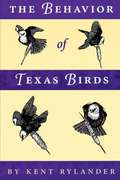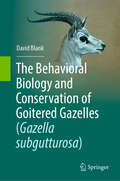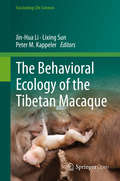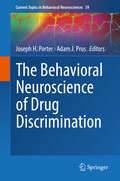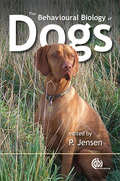- Table View
- List View
The Beekeeper's Field Guide: A Pocket Guide to the Health and Care of Bees
by David CrampThis guide is a diagnostic tool and an aide memoire for the hobbyist and for the professional beekeeper, who may know what to do but will at times need the information close to hand. It includes: - A troubleshooting guide to problems with colonies and queen bees - A guide to the field diagnosis, treatment and control of diseases - Seasonal apiary management checklists - Hive product harvesting checklists - The beekeeper's ready reckoner The second and revised edition of this fully illustrated and handy guide to the apiary brings the science and craft of beekeeping to beekeepers right where they need it - in the field with the bees.Contents: Preface; List of figures; List of photographs; List of tables; Picture credits; Introduction; Part A: Setting up an Apiary; Part B: Crops, Trees and Plants for Bees; Part C: Troubleshooting Guide to Field Operations; Part D: Swarm Prevention and Control; Part E: Queen Bees; Part F: Honey Harvest Procedures; Part G: Hive Checks; Part H: Pests and Diseases; Part I: A Beekeeper's Ready-reckoner; Part J.
The Beekeeper's Guide: Building Skills and Knowledge
by Claire Jones Meredith May Anne Rowberry Margaret MurdinA comprehensive guide on establishing and maintaining beehivesBeekeeping is a popular pastime that more and more people are taking up for fun or even modest profit. Today, you will find hives not only in large fields or rural spaces, but also in city gardens and on rooftops—to the benefit of both bee and beekeeper. If you&’re at the early or middle stages of your beekeeping journey and need a go-to guide on establishing and maintaining your hives, The Beekeeper&’s Guide is the perfect companion. It offers invaluable information about a wide range of bee species and their life cycle, behavior, and optimal habitat, and covers the practicalities of beekeeping, from personal safety and hive hygiene to feeding methods and record keeping. Complete with an extensive troubleshooting section and a directory of useful resources, The Beekeeper&’s Guide is a comprehensive tool for all beekeepers.
The Beekeeper's Handbook
by Diana Sammataro Alphonse Avitabile Dewey M. CaronSince 1973, tens of thousands of first-time and experienced beekeepers alike have relied on The Beekeeper's Handbook as the best single-volume guide to the hobby and profession of beekeeping. Featuring clear descriptions and authoritative content, this handbook provides step-by-step directions accompanied by more than 100 illustrations for setting up an apiary, handling bees, and working throughout the season to maintain a healthy colony of bees and a generous supply of honey. This book explains the various colony care options and techniques, noting advantages and disadvantages, so that beekeepers can make the best choices for their own hives. This fourth edition has been thoroughly redesigned, expanded, updated, and revised to incorporate the latest information on Colony Collapse Disorder, green IPM methods, regional overwintering protocols, and procedures for handling bees and managing diseases and pests such as African honey bees and bee mites. The book explains not only how but also why each step is part of the transformative process that results in the magnificent creation of honey. This essential guide is a beekeeper's most valuable resource. Colony Collapse Disorder has renewed our recognition of the importance of small-scale beekeeping and the critical role of bees in the production of our food supply. For the growing number of beekeepers looking to set up hives for either a rewarding hobby or a profitable commercial enterprise, this updated and revised essential how-to guide includes: - step-by-step directions for all stages from setting up an apiary to harvesting honey; - approximately 100 illustrations featuring techniques, equipment, and bee biology; - information about how to manage new pests and diseases including Colony Collapse Disorder; - coverage of new trends and changes in beekeeping including green IPM techniques and new laws for urban beekeeping; - the most up-to-date bibliography and list of resources on the topic; and - a new user-friendly book design that clearly highlights instructions and other important features.
The Beekeeper's Handbook (3rd edition)
by Diana Sammataro Alphonse AvitabileDiana Sammataro and Alphonse Avitabile have revised and expanded their clear and comprehensive guide to cover changes in beekeeping. They discuss the crisis created by the parasitic bee mites. In less than a decade, for example, Varroa mites have saturated the North American honeybee population with disastrous results, devastating both managed and wild populations. The new edition of The Beekeeper's Handbook covers mite detection and control as well as the selection and testing of bees that may have some tolerance to mites.
The Beekeeper's Lament: How One Man and Half a Billion Honey Bees Help Feed America
by Hannah Nordhaus“A crackerjack story of one American beekeeper’s days . . . presented within the context of beekeeping’s natural and social history” (Kirkus, starred review).“A rollicking, buzzing, and touching meditation on mortality. . . . You’ll never think of bees, their keeper, or the fruits (and nuts) of their labors the same way again.” —Trevor Corson, author of The Secret Life of Lobsters and The Story of SushiThe honey bee is a willing conscript, a working wonder, an unseen and crucial link in America’s agricultural industry. But never before has its survival been so unclear—and the future of our food supply so acutely challenged.Enter beekeeper John Miller, who trucks his hives around the country, bringing millions of bees to farmers otherwise bereft of natural pollinators. Even as the mysterious and deadly epidemic known as Colony Collapse Disorder devastates bee populations across the globe, Miller forges ahead with the determination and wry humor of a true homespun hero. The Beekeeper’s Lament tells his story and that of his bees, making for a complex, moving, and unforgettable portrait of man in the new natural world.“I loved The Beekeeper’s Lament. With great reporting and great writing, Hannah Nordhaus gives a new angle on an ever-evolving topic. You’ll learn a lot.” —Bernd Heinrich, author of Winter World and Mind of the Raven“An engaging account of the men and insects who put food on our tables. The Beekeeper’s Lament is a sweet, sad story.” —Elizabeth Kolbert, author of Field Notes from a Catastrophe
The Beekeeper's Problem Solver: 100 Common Problems Explored and Explained
by James E. TewAuthor, experienced beekeeper, and apiary expect James E. Tew explains 100 common problems faced by beekeepers, clearly spelling out their underlying causes and how to solve all of them.Beekeeping requires understanding, commitment, and attention to detail. Laying the groundwork for a successful hive is essential, and demands a keen appreciation of critical areas like hive management, breed choice, and health requirements.Bees often disguise problems, though, making recognizing trouble in the crucial, initial stages that much more difficult. Whether you’re a newcomer or an old hand, The Beekeeper’s Problem Solver provides the information you need to nip problems in the bud, or avoid them in the first place.With color photography throughout and a glossary of terms at the back, each beekeeping problem is tackled in depth, covering a wide range of practical tips and useful insights. The problems are conveniently organized into the following categories: ·Beekeeping Basics – My new bees arrived during a cool, rainy period. … ·Beekeeping Equipment – The beehive smoker will not stay lit. … ·Biology and Behavior of the Colony – There are many dead drones at the hive entrance. … ·Managing and Manipulating Hives – The brood nest has been built across multiple boxes. … ·Queen Production and Maintenance – The queen is not a good egg producer. … ·Diseases and Pests of Honey Bees – Varroa mites have overrun the colony. … ·Pollen and Pollination – Too few bees are pollinating the target crop. … ·Producing and Processing Honey – The honey filter keeps getting clogged. … ·Beeswax, Propolis, and Specialty Issues – Propolis is difficult to gather and process. … Don’t lose your hive to something preventable, just grab your problem solver!
The Beekeepers: How Humans Changed The World Of Bumble Bees (Scholastic Focus)
by Dana L. ChurchBumble bees are as familiar to most of us as the flowers these fuzzy insects feed upon. But did you know that the bees in your garden could be escapees from a local greenhouse, or descended from stowaways on a Viking ship?Bumble bees are a vital part of our lives and Earth's ecosystems, so much so that we've commercialized their breeding and shipped them across states, countries, and ecosystems for our benefit. However, all of that human interference has consequences. Bumble bees are pushing out native species and altering ecosystems worldwide. Pesticide use has led to the spread of disease in local colonies. And some species may be disappearing entirely.The Beekeepers is an expertly researched overview of bumble bees -- from hive hierarchies to how their brains work -- and the passionate humans and scientists who are fighting for their survival. With a thoughtful and accessible voice, researcher Dana Church introduces readers to the fascinating world of bumble bees, how and why some are thriving while others are floundering, and how both experts and regular citizens are working to ensure their future. Equal parts endearing, frustrating, and hopeful, this scientific narrative is essential for readers looking to understand and make an impact on our changing world.
The Bees In Your Backyard: A Guide To North America's Bees
by Joseph S. Wilson Olivia Messinger CarrilThe Bees in Your Backyard provides an engaging introduction to the roughly 4,000 different bee species found in the United States and Canada, dispelling common myths about bees while offering essential tips for telling them apart in the field. It describes their natural history, including where they live, how they gather food, their role as pollinators, and even how to attract them to your own backyard. Ideal for amateur naturalists and experts alike, it gives detailed accounts of every bee family and genus in North America, describing key identification features, distributions, diets, nesting habits, and more.
The Bees of Notre-Dame
by Meghan P. BrowneThis lyrical, poignant nonfiction picture book tells the fascinating story of the honeybee colonies that lived on the roof of the Notre-Dame Cathedral in Paris and survived the devastating 2019 fire. <p><p> High above the bustling streets and gardens of Paris is a little-known wonder: a cluster of beehives. They sit atop the roof of the Notre-Dame cathedral, lovingly tended to by a beekeeper named Sibyle. But when fire broke out in the catherdral in 2019, the bees almost didn’t make it. Firefighters battled heat and smoke, carefully spraying their hoses around the hives, pumping in water from fireboats on the Seine, and, miraculously, they survived. <p><p> Meghan P. Browne and E. B. Goodale imbue the story of Notre-Dame’s bees and the fire that almost killed them with great hope. After the fire, there is rebuilding to be done, but with hard work and collaboration, perhaps the cathedral can be restored after all. From the rooftops of Paris to the intricacies of a beehive, here is a moving picture book about resilience in the face of disaster.
The Bees of the World
by Charles D. MichenerIn this extensive update of his definitive reference, Charles D. Michener reveals a diverse fauna that numbers more than 17,000 species and ranges from the common honeybee to rare bees that feed on the pollen of a single type of plant. With many new facts, reclassifications, and revisions, the second edition of The Bees of the World provides the most comprehensive treatment of the 1,200 genera and subgenera of the Apiformes. Included are hundreds of updated citations to work published since the appearance of the first edition and a new set of plates of fossil bees.The book begins with extensive introductory sections that include bee evolution, classification of the various bee families, the coevolution of bees and flowering plants, nesting behavior, differences between solitary and social bees, and the anatomy of these amazing insects. Drawing on modern studies and evidence from the fossil record, Michener reveals what the ancestral bee—the protobee—might have looked like. He also cites the major literature on bee biology and describes the need for further research on the systematics and natural history of bees, including their importance as pollinators of crops and natural vegetation. The greater part of the work consists of an unprecedented treatment of bee systematics, with keys for identification to the subgenus level. For each genus and subgenus, Michener includes a brief natural history describing geographical range, number of species, and noteworthy information pertaining to nesting or floral biology.The book is beautifully illustrated with more than 500 drawings and photographs that depict behavior, detailed morphology, and ecology. Accented with color plates of select bees, The Bees of the World will continue to be the world's best reference on these diverse insects.
The Beeswax Workshop: How to Make Your Own Natural Candles, Cosmetics, Cleaners, Soaps, Healing Balms and More
by Christine J. DalzielOver 100 recipes to transform this miracle ingredient into environmentally friendly household cleaner, personal care products, candles, and more.Making all kinds of amazing, all-natural stuff out of beeswax is easy and fun. Packed with over 100 step-by-step recipes, The Beeswax Workshop shows you how to make beautiful gifts, household cleaners, beauty supplies and so, so much more. Projects in this book include:HOME• Mason Jar Candle• English Furniture PolishHEALTH• Bug-Be-Gone Insect Repellent• Chamomile Sunburn SalveBEAUTY• Everyday Body Butter• Rose Lip GlossGARDEN• Waterproof Shade Hat• Nontoxic Wood SealantWhether you use beeswax from your backyard hive or purchase a supply, this book offers tips, tricks and techniques for getting the most out of this miracle ingredient.
The Beetle Alphabet Book
by Jerry PallottaUses letters of the alphabet to introduce various kinds of beetles.
The Beetle Alphabet Book (Jerry Pallotta's Alphabet Books)
by Jerry PallottaLearn your beetles from A to Z as they crawl their way through the alphabet. Get to know the most diverse species on earth in this entertaining and informative nature ABC book. From the Dung Beetle to the Kalahari Beetle to the Zinc Metallic Beetles, the book is both fact-filled and fun for young readers. Full of Jerry Pallotta's signature humor and brought to life with bold artwork by award-winning illustrator, David Biedrzycki. A great introduction for the insect-enthused and lovers of all things that creep and crawl.
The Beetle Book
by Steve JenkinsBeetles squeak and beetles glow. Beetles stink, beetles sprint, beetles walk on water. With legs, antennae, horns, beautiful shells, knobs, and other oddities--what's not to like about beetles? The beetle world is vast: one out of every four living things on earth is a beetle. There are over 350,000 different species named so far and scientists suspect there may be as many as a million. From the goliath beetle that weighs one fourth of a pound to the nine inch long titan beetle, award-winning author-illustrator Steve Jenkins presents a fascinating array of these intriguing insects and the many amazing adaptations they have made to survive.
The Beginner's Dog Training Guide: How to Train a Superdog, Step by Step
by Gwen BaileyUnleash your dog's potential and build a rewarding relationship that will last a lifetime!From walking on a loose lead to carrying the shopping, The Beginner's Dog Training Guide has everything you need to know to train your dog and ensure you have a happy canine companion. Choose the right dog breed for you and then keep your dog healthy by understanding their exercise, diet, and grooming needs. Follow clear, step-by-step explanations and illustrations to learn every aspect of owning and training a dog, from basic obedience to advanced tricks.Expert advice accompanied by over 800 clear photographs provide a user-friendly visual guide to training your dog, by showing you exactly what to do. Filled with tips and tricks, this book will help you become the owner of a well-behaved, healthy, and happy dog!This dog training book promises:- An easy-to-follow approach to understanding dog behavior and dog training based on the latest research into canine intelligence- Offers expert guidance on selecting the right dog for you, with a catalog of the most popular breeds- Features behavioral analysis to help you understand what your dog is thinking- More than 800 photographs provide clear visual guidance so you know exactly what to do to succeed with your dog A must-have volume for families training their new pet, for first-time dog owners and experienced owners alike as well as those interested in training theory and dog psychology.
The Beginner's Guide to Chicken Breeds: An Introductory Guide to Choosing the Right Flock
by Amber BradshawGrow your flock with practical, breed-specific advice for beginners Deciding to raise chickens is one thing, but figuring out which breeds will suit your needs is another—especially with hundreds of different types! Whether you're raising chickens for eggs, meat, companionship, or show, The Beginner's Guide to Chicken Breeds has all the information you need to get started. This easy-to-use reference book helps you assess your needs and guides you in making the best decisions for beginning or expanding your flock. Get to know top-tier pure breeds and hybrids, optimal egg-layers and broilers, ideal chicken breeds for beginners, and more. For every category of chicken, you'll find an ultimate breed list that highlights the unique qualities and strengths of each, and breaks down the key considerations of owning them. The Beginner's Guide to Chicken Breeds includes: Beginner-friendly guidance—Get started with expert insights, answers to commonly asked questions, lists of pros and cons, and a best-fit questionnaire to help you narrow down the right chicken breeds for you. Cost estimates—Plan for all the expenses associated with raising a backyard flock, including the chicken coop, food, veterinary bills, cleaning products, and other supplies. Chicken characteristics—Explore key breed-specific traits, including average weight and appearance, harvest age, egg production and color, temperament, climate hardiness, and more. Discover everything you need to know to pick the perfect chicken breeds for your lifestyle with this essential beginner's guide.
The Beginner's Guide to Raising Chickens: How to Raise a Happy Backyard Flock
by Anne KuoThe beginner's complete guide raising happy backyard chickens—your new summer activity!The Beginner's Guide to Raising Chickens makes it easy to start keeping these surprisingly smart birds right in your own backyard. From constructing coops to rearing chicks, you'll learn everything you need to know to make sure your chickens stay happy and healthy all year round.Which breed of chicken is right for you? What's the best bedding material? What sort of feed should you use? Expert chicken keeper Anne Kuo answers these questions—and many others—in this fun and friendly reference book that will get you excited to raise your new feathered friends.This book on raising chickens guides you through:Getting from the chicken to the egg—Find out how to raise chicks, keep your birds safe from predators, introduce new birds to the flock, and more.Creating a custom coop—Build the perfect home for raising chickens with detailed backyard coop construction guides.Expert care advice—Learn how to identify different behaviors in your chicken, help solve egg shortages, and navigate a range of potential surprises with confidence.Start the perfect summer hobby when you grab the The Beginner's Guide to Raising Chickens.
The Beginner’s Guide to Raising Goats: How to Keep A Happy Herd
by Amber BradshawMake bucks (and plenty of kids) by raising goats.Whether you're looking to be self-sufficient, or you want to make some money on the side, goats are perfect for milk and cheese, meat, and fiber. Taking care of goats could be your newest summer activity. The Beginner's Guide to Raising Goats can help you get the most out of these hearty herd animals with step-by-step instructions and easy-to-follow tips for newcomers.From Angoras to Nigerian Dwarfs, this beginner's guide to raising goats will break down the dos and don'ts to starting your herd. Learn how to pick the right kind of goat for your homestead's needs, build fences and shelters, feed and breed them, and more. Raising goats can be a wonderful adventure in family fun this summer, that not only teaches valuable life skills to the younger ones but also delivers a valuable resource to your table. There's even a recipe section in the back that shows you how to use their fresh meat and milk to make tasty home-cooked meals like Goat Chili and Goat Mac N' Cheese.The Beginner's Guide to Raising Goats features:Goats 101—Discover an in-depth overview that gives you everything you need to know about raising goats.Share your bounty—Explore practical tips that show you how to start a side business selling goat milk, cheese, and meat.Dollars & sense—Get a cost estimate and approximate timelines for raising animals, making dairy products, and selling them for profit.Learn how goats can help create a more sustainable life with this essential beginner's guide.
The Beginning of the Age of Mammals
by Kenneth D. RoseIn the tradition of G. G. Simpson's classic work, Kenneth D. Rose's The Beginning of the Age of Mammals analyzes the events that occurred directly before and after the mysterious K-T boundary which so quickly thrust mammals from obscurity to planetary dominance. Rose surveys the evolution of mammals, beginning with their origin from cynodont therapsids in the Mesozoic, contemporary with dinosaurs, through the early Cenozoic, with emphasis on the Paleocene and Eocene adaptive radiations of therian mammals. Focusing on the fossil record, he presents the anatomical evidence used to interpret behavior and phylogenetic relationships. The life's work of one of the most knowledgeable researchers in the field, this richly illustrated, magisterial book combines sound scientific principles and meticulous research and belongs on the shelf of every paleontologist and mammalogist.
The Behavior of Animals: Mechanisms, Function, and Evolution
by Luc-Alain Giraldeau Jerry A. Hogan Johan J. BolhuisThe Behavior of Animals An updated view of animal behavior studies, featuring global experts The Behavior of Animals, Second Edition provides a broad overview of the current state of animal behavior studies with contributions from international experts. This edition includes new chapters on hormones and behavior, individuality, and human evolution. All chapters have been thoroughly revised and updated, and are supported by color illustrations, informative callouts, and accessible presentation of technical information. Provides an introduction to the study of animal behavior Looks at an extensive scope of topics- from perception, motivation and emotion, biological rhythms, and animal learning to animal cognition, communication, mate choice, and individuality. Explores the evolution of animal behavior including a critical evaluation of the assumption that human beings can be studied as if they were any other animal species. Students will benefit from an updated textbook in which a variety of contributors provide their expertise and global perspective in specialized areas
The Behavior of Texas Birds
by Kent RylanderWhether it's the sudden, plunging dives of Brown Pelicans, the singing and aerial displays of Northern Mockingbirds, or the communal nesting of Purple Martins, innate and learned behaviours are some of the most fascinating things to observe in Texas birds. Even casual birdwatchers eventually ask, ""why do they do that?"" while serious birders and ornithologists seek to understand all the behaviours involved in feeding, flying, mating, and rearing young. But until now, it has been hard to find this information in one handy source. In this comprehensive, yet easy-to-use book, Kent Rylander distils data from many sources to provide an authoritative guide to the behaviour of Texas birds. He begins by explaining the principles of animal behaviour and illustrating how they can be applied to interpreting bird behaviours in the field. The majority of the book is devoted to accounts of more than 400 species of birds that are most likely to be encountered by Texas birdwatchers. Each account describes such behaviours as feeding, courtship, parenting, and other behaviours that are significant for that species.
The Behavioral Biology and Conservation of Goitered Gazelles (Gazella subgutturosa)
by David BlankThis comprehensive and lavishly illustrated book summarizes all known information on the Goitered Gazelle (Gazella subgutturosa), one of the world's most endangered antelopes. It includes information on topics such as feeding ecology, behavior, vocalizations, parasites and diseases, and conservation. This research monograph will be of interest to professional researchers of ungulates, university staff, students, and naturalists.
The Behavioral Ecology of the Tibetan Macaque (Fascinating Life Sciences)
by Peter M. Kappeler Jin-Hua Li Lixing SunThis open access book summarizes the multi-disciplinary results of one of China’s main primatological research projects on the endemic Tibetan macaque (Macaca thibetana), which had continued for over 30 years, but which had never been reported on systematically. Dedicated to this exceptional Old World monkey, this book makes the work of Chinese primatologists on the social behavior, cooperation, culture, cognition, group dynamics, and emerging technologies in primate research accessible to the international scientific community.One of the most impressive Asian monkeys, and the largest member of its genus, the Tibetan macaque deserves to be better known. This volume goes a long way towards bringing this species into the spotlight with many excellent behavioral analyses from the field. - Frans de Waal, Professor of Psychology, Emory University, USA.Macaques matter. To understand primate patterns and trends, and to gain important insight into humanity, we need to augment and expand our engagement with the most successful and widespread primate genus aside from Homo. This volume focuses on the Tibetan macaque, a fascinating species with much to tell us about social behavior, physiology, complexity and the macaque knack for interfacing with humans. This book is doubly important for primatology in that beyond containing core information on this macaque species, it also reflects an effective integrated collaboration between Chinese scholars and a range of international colleagues—exactly the type of collaborative engagement primatology needs. This volume is a critical contribution to a global primatology. - Agustín Fuentes, Professor of Anthropology, University of Notre Dame, USA. I have many fond memories of my association with Mt. Huangshan research beginning in 1983, when together with Professor Qishan Wang we established this site. It is such a beautiful place and I miss it. It is gratifying to see how far research has progressed since we began work there, becoming more internationalized and very much a collaborative endeavor under the long-term direction of Professor Jin-Hua Li and colleagues. This book highlights the increased interest in this species, representing a variety of disciplines ranging from macro aspects of behavior, cognition and sociality, to micro aspects of microbes, parasites and disease, authored by a group of renowned Chinese and international primatologists. I applaud their efforts and expect more interesting work to come from this site in the years ahead. - Kazuo Wada, Professor Emeritus, Kyoto University, Japan.
The Behavioral Neuroscience of Drug Discrimination (Current Topics in Behavioral Neurosciences #39)
by Joseph H. Porter Adam J. PrusThe goal for this volume is to provide an up-to-date review of the discriminative stimulus properties of major psychoactive drug classes with an emphasis on how this paradigm enhances our understanding of these drugs and how these findings translate from animals to humans. The drug discrimination paradigm applies to both drugs of abuse and drugs for treating mental illnesses, and research from these studies has provided immense translational value for learning about the mechanisms responsible for drug effects in humans.
The Behavioural Biology of Dogs
by Per JensenAs humans oldest domesticated animals, dogs serve as an excellent model for studying how mammal behavior and cognition have evolved. So states Jensen (biology, Linköping U., Sweden) in introducing 14 chapters intended for students in animal behavior or veterinary medicine. International researchers present up-to-date information on aspects of Caninae species diversity and behavior in evolutionary and social ecological contexts. General readers may find the sections treating dog personality, behavioral problems and their link to disease of interest. Lightly-illustrated chapters include references and further suggested reading.
